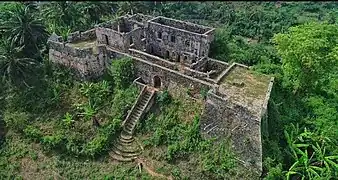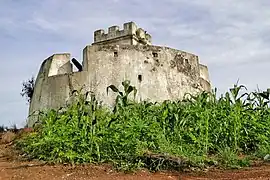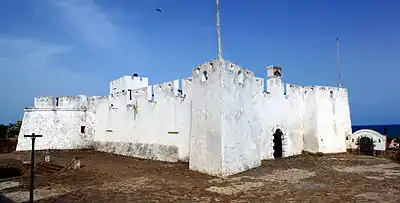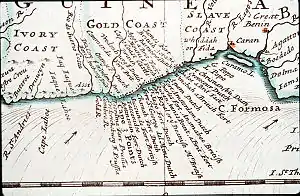
During the colonial period in Ghana, at the time known as the Gold Coast, roughly corresponding to the 15th through 19th centuries, European-style coastal forts and castles were built, mostly by the Portuguese, Dutch and British.[1] These forts linked the trading routes established by the Portuguese and acted as important market places for the gold and slave trades.[1]
Because of their testimony to precolonial and colonial Afro-European commerce, including the Atlantic slave trade, and their profound effect on the history of West Africa, a number of these fortifications and outposts were designated as a World Heritage Site by UNESCO in 1979.[1]
Kumasi Fort in the Ashanti Region was originally built by an Asante king in imitation of these colonial forts.[2]
Coastal regions
World Heritage listed forts
| UNESCO World Heritage Site | |
|---|---|
 | |
| Location | |
| Includes | |
| Criteria | Cultural: (vi) |
| Reference | 34 |
| Inscription | 1979 (3rd Session) |
Forts and Castles, Volta, Greater Accra, Central and Western Regions is the collective designation by UNESCO of European-style fortifications and outposts (mostly Portuguese, Dutch and British) along the Gold Coast (modern-day Ghana) during the colonial period. The term specifically applies to a number of such fortifications designated as a World Heritage Site by UNESCO in 1979, including:[1]
- Three castles:
- Fifteen forts:
- Good Hope at Senya Beraku
- Patience at Apam
- Amsterdam at Abandze
- St. Jago at Elmina
- San Sebastian at Shama
- Metal Cross at Dixcove
- St. Anthony at Axim
- Orange at Sekondi
- Fort Groß Friedrichsburg at Prince's Town
- William (Lighthouse) at Cape Coast
- William at Anomabu
- Victoria at Cape Coast
- Ussher at Usshertown, Accra
- James at Jamestown, Accra
- Apollonia at Beyin
- Four forts partially in ruins:
- Amsterdam at Abandze (Note, this fort is listed both as fort and as fort partially in ruins by UNESCO)
- English Fort at British Komenda
- Batenstein at Butre;
- Prinzensten at Keta
- Ruins with visible structures:
- Nassau at Mouri
- Fredensborg at Old Ningo
- Vredenburg at Dutch Komenda
- Vernon at Prampram
- Dorothea at Akwidaa
- Two sites with traces of former fortifications:
- Frederiksborg at Amanful, Cape Coast
- Fort Augustaborg at Teshie
Gallery
Other coastal forts
Other coastal forts included in Ghana's material cultural heritage list of the Ghana Museums and Monuments Board:[3]
- Fort Fredericksburg at Amanful (distinguished from Fort Frederiksborg/Fort Royal near Cape Coast Castle)
- Fort McCarthy at Cape Coast
- The Little Fort at Anomabu
- Fort Tantumquery at Otuam
Not listed as heritage (mostly largely destroyed or otherwise lost):
- Fort Winneba at Winneba
- Fort Sekondi at Sekondi
- Fort Kongenstein at Ada
- Fort Elize Carthago near Axim
- Fort Ruychaver on the banks of the Ankobra River
- Fort Witsen near Sekondi
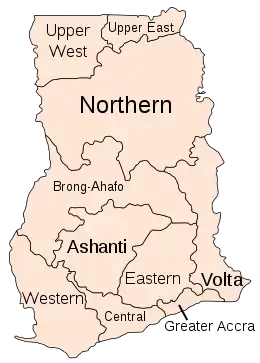
By region (from East to West):
- Volta Region:
- Greater Accra Region:
- Fort Fredensborg, Old Ningo (5°45′04″N 0°11′01″E / 5.751°N 0.1835°E)
- Fort Vernon, Prampram (5°43′31″N 0°07′00″E / 5.7253°N 0.1168°E)
- Fort Augustaborg, Teshie (5°35′00″N 0°06′00″W / 5.583333°N 0.100000°W)
- Osu Castle (Christiansborg), Accra (5°32′49″N 0°10′57″W / 5.54694°N 0.18250°W)
- Ussher Fort, Accra (5°32′19″N 0°12′30″W / 5.5385°N 0.2082°W)
- Fort James, Accra (5°32′01″N 0°12′40″W / 5.5337°N 0.2111°W)
- Central Region:
- Fort Good Hope (Fort Goede Hoop), Senya Beraku (5°23′15″N 0°29′23″W / 5.3874°N 0.4898°W)
- Fort Lijdzaamheid ('Patience'), Apam (5°17′10″N 0°43′41″W / 5.286°N 0.7281°W)
- Fort Amsterdam, Abandze (5°11′32″N 1°05′35″W / 5.192222°N 1.093056°W)
- Fort William, Anomabu (5°10′27″N 1°07′08″W / 5.17419°N 1.1189°W)
- Fort Nassau, Moree (5°08′00″N 1°12′00″W / 5.133333°N 1.2°W)
- Cape Coast Castle, Cape Coast (5°06′12″N 1°14′33″W / 5.10333°N 1.24250°W)
- Fort William (Lighthouse), Cape Coast (5°06′29″N 1°14′39″W / 5.10797°N 1.24428°W)
- Fort Victoria, Cape Coast (5°06′24″N 1°14′57″W / 5.1068°N 1.2491°W)
- Elmina Castle, Elmina (5°04′57″N 1°20′53″W / 5.082600°N 1.348100°W)
- Fort Coenraadsburg, Elmina (5°05′04″N 1°21′03″W / 5.08444°N 1.35083°W)
- Fort Vredenburgh, Komenda (5°03′06″N 1°29′01″W / 5.051745°N 1.483541°W)
- English Fort, Komenda (5°03′00″N 1°29′22″W / 5.050000°N 1.489444°W)
- Western Region:
- Fort San Sebastian, Shama (5°00′39″N 1°37′45″W / 5.010825°N 1.629199°W)
- Fort Orange, Sekondi (4°56′09″N 1°42′26″W / 4.9357°N 1.7073°W)
- Fort Batenstein, Butri (4°49′37″N 1°55′17″W / 4.826944°N 1.921389°W)
- Fort Metal Cross, Dixcove (4°47′36″N 1°56′42″W / 4.79335°N 1.9451°W)
- Fort Groß Friedrichsburg, Prince's Town (4°47′28″N 2°08′02″W / 4.791083°N 2.133889°W)
- Fort Santo Antonio, Axim (4°52′05″N 2°14′40″W / 4.8680°N 2.2444°W)
- Fort Apollonia, Beyin (4°59′15″N 2°35′25″W / 4.9874°N 2.5902°W)
Other regions
- Kumasi Fort in the Ashanti Region.[2]
See also
References
- 1 2 3 4 "Forts and Castles, Volta, Greater Accra, Central and Western Regions". UNESCO World Heritage Convention. Retrieved 9 Oct 2022.
- 1 2 Kumasi Fort and Military Museum at www
.ghanamuseums .org - ↑ Forts and Castles at Ghana Museums and Monuments Board website
External links
- Ghana-Net: Forts and Castles of Ghana (with pictures)
- Ghana Place Names: Forts & Castles (meanings and origins of names)
.jpg.webp)
.jpg.webp)
_2012-09-29_08-31-04.jpg.webp)
